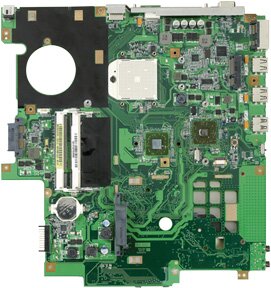Nowhere is this more clearly shown than with the development and miniaturisation of successive Eee PC™ motherboards.
The Eee PC™ 1008HA motherboard is a fraction of the size of the Eee PC™ 901’s and is the size of a credit card!”
Due to obvious space constraints, laptop motherboards need to be designed to a set of different criteria than those for desktop PCs. The lack of expansion slots means that components need to be tightly integrated, and cooling needs to be considered right from the very start. The shape of a laptop case also affects the placement of external ports — ports may need to be placed at the sides if a battery occupies the rear of a laptop, for example.

The motherboard inside a standard 15-inch laptop
The size of a laptop motherboard is also dictated by the size of the laptop case — or vice versa, depending on how a laptop design is initiated. Its long experience with motherboard design has meant that ASUS has always been on the forefront when it comes to laptop innovations.
Standard 15” Laptop ►
This is a typical 15″ laptop motherboard, measuring approximately 260 x 250mm. The processor socket is clearly visible, as are the empty memory slots, together with the USB and other expansion ports on two edges.

The motherboard inside an ASUS Eee PC 1008HA laptop
ASUS Eee PC 1008HA
When it came to designing the revolutionary Eee PC™ 1008HA Seashell, ASUS faced a new challenge. Not only is this stunning netbook barely 1″ thick, but the case tapers to just a few millimetres and so there simply isn’t room for a more traditional motherboard design — no matter how small. The ASUS R&D team was able to solve the problem by creating a completely new — and incredibly small — motherboard design. Measuring just 83 x 110mm, the Eee PC™ 1008HA motherboard is a fraction of the size of the Eee PC™ 901’s and is the size of a credit card!











